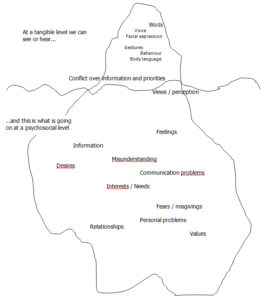| Exercise, handout number | Time | Method | Materials |
| Opening session | 15 min | Plenary | |
| Game with feelings | 15 min | Exercise | Copy |
| Difficult statements in school | 20 min | Plenary | Copy |
| Reflect back | 15 min | Introduction and questions | Copy |
| Introduction of the ice-berg model and application | 30 min | Application of the role play | Copy |
| I-statements | 30 min | Copy | |
| Evaluation | 10 min |
Handout 17: Dealing with feelings
Helpful sentences:
- If I understood you the right way, you feel… Am I right?
- Could it be that you feel…?
- My impression is that you are sad (angry, hurt…), because…
- You seem to be very upset, am I right?
 |
Source:
|
Handout 18A: Exercise: Difficult statements in School Mediation
Imagine situations in a peer mediation in which a student makes the following statements. Each statement stands on its own – there is no connection between situations.
Try out each scene for a moment to get a feeling for the situation. Consider which feelings, desires and wishes could be hidden behind the statement. Then think of possible ways the mediators might react, e.g. ask for concrete information, have the parties reconstruct the situation, reflect back what you have heard, reflect back the feelings, ask the party to express his or her feelings or to reward a reproach into a desire, ask if there has ever been an exception. Often it will be important to use several techniques – what is important is the order in which you use them. Try out different reactions in a mini-role play but please avoid asking “why” as this might put people on the defensive.
1. He started! He kicked me first!
Feelings:
Desires / interests:
Mediators’ reaction:
2. She’s always doing that! It drives me crazy!
Feelings:
Desires / interests:
Mediators’ reaction:
3. I didn’t mean it like that – she shouldn’t take it personally.
Feelings:
Desires / interests:
Mediators’ reaction:
4. That’s absolutely not true! She’s lying!
Feelings:
Desires / interests:
Mediators’ reaction:
 |
Source:
|
Handout 18: Reflect back
To reflect back is an essential communication technique during the whole mediation process. The mediators repeat what has been said by the parties in their own words and if necessary ask for clarification. Here are some helpful sentences:
- Do you think that…?
- Did I understand you right?
- You seem to be …
- Let me see whether I understood what you mean…
- My perception is that you are…
- Could it be that…
- You think perhaps that…
- I noticed that you were nearly crying when you talked about…
- On the whole, I think you mean…
 |
Source:
|
Handout 19: The Iceberg Model of Conflict Dynamics

 |
Duration:
10 minutes |
 |
Aim:
The participants become acquainted with one of the most popular models reflecting conflict dynamics: the iceberg model. It is an easy and directly applicable tool in order to understand conflict dynamics. |
 |
Materials:
Flipchart No. 1, (flipchart samples see additional material) |
 |
Instruction for implementation:
One trainer draws the shape of an iceberg on a flipchart, then invites the participants to name signals for a conflict between two parties which can be immediately recognized and include them in the visible part of the iceberg. But what lies underneath? What can´t be seen at first sight? Have the participants reflect the hidden aspects of a conflict and write them down. Evaluation procedure: The exercise is a good opportunity to sensitize students to have a second look at a given situation and try to understand what is below the water surface. |
Handout 20: I – statements
In order to support an open and authentic dialogue, mediators should encourage students to use I – statements. Instead of accusing the other partner of a certain behavior or using a put-down, the students express what the situation meant to them, how they felt etc. Marshall Rosenberg, a famous American psychologist, developed the concept of Nonviolent Communication.
When students express their personal feelings the focus is shifted from an accusation to the feelings or thoughts which arose after a certain behavior.
An example:
“I am hurt/angry/upset… when you call me names/ talk behind my back/ exclude me for no reason…”
A more detailed I statement consists of four steps:
“When you…
I feel/ am…
Because…
And I want…
Situation 1:
Marco´s parents cannot afford to buy new sports clothes for him. Peter is making fun of him because he is still wearing the old fashioned clothes.
Marco:
Situation 2:
Susan got a bad mark in the latest math test. Irene is laughing at her and calls her a dummy.
Susan: